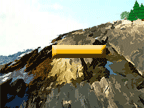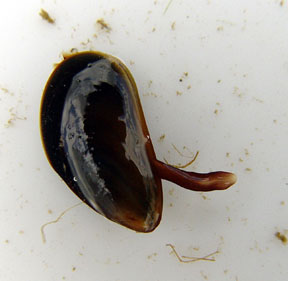 |
 |
|||||||||||||||
|
Mytilus edulis reproduces by external fertilization and females can release up to 25 million eggs a season. Males simultaneously release millions of sperm into the water. After fertilization the mussels assume a planktonic larval life for three months, swept to areas along the shore by currents. As development progresses the mussel larvae will settle out of the water column to the ocean bottom. Once on the bottom they use a tiny foot to move themselves to hard substrate (see picture above right). When a good location is found, it anchors itself to the substrate with special lines called byssal (bis-sell) threads. The byssal threads are made in a special gland in the foot of the mussel. Byssal threads stretch out in many directions securely holding the mussel on the rock and to each other. Not even the crashing waves can knock them loose. The shape of a mussel's shell is also adaptive for living on exposed sites. One end of the mussel is narrow and is oriented so that it faces incoming waves, minimizing damage. |
||||||||||||||||
Did you know... |
||||||||||||||||
|
||||||||||||||||



